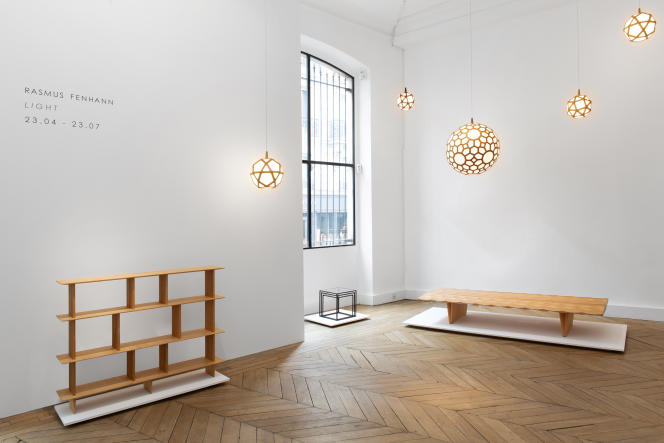With the beautiful season, we can finally take the time to discover beautiful objects or pride ourselves on decorative art and design. Zoom on three exhibitions of the moment, in Paris: two of them devote confirmed talents who come together around their love of wooden constructions; the third brings together six young creators combining the most diverse materials, pushing the boundaries of their art.
Rasmus Fenhann, between Danish simplicity and Japanese tradition
Globular lamps as faceted as a fly’s eye, origami-style coffee tables or secret boxes with drawers smaller than a matchbox: the geometric pieces in wood, glass or translucent paper by Dane Rasmus Fenhann invite you on a journey through the exceptional. In this exhibition called “Light” (that is, “light” but also “light”), this double graduate at the Royal Academy of Art and Design, in cabinetmaking in 1996 and in design in 2003, plays with oak species , cherry, pear or Japanese ebony, the balance of lines, transparency.
To achieve this level of perfection and complexity, the 50-year-old artist combines cutting-edge technology with almost forgotten artisanal processes. This is illustrated by this chair whose backrest, partially obliquely, pierces the seat, fixed below by simple wooden pegs. It recalls the shape of the paper clip that catches the paper, hence its name Clip, but the technique dates back to ancient Egypt.
Another ubiquitous source of inspiration is Japan, where Rasmus Fenhann spent several months, notably with art master Norio Fukushima. His slender bookcases borrow the way used to make sliding doors in the land of the Rising Sun.
His Hikari (“light” in Japanese) series lamps are a masterpiece of construction, like the Contrahedron pendant lamp on display, which – with its 150 fine ribbons of Oregon pine and small pieces of Japanese kozo paper – entered the permanent collection of the Design Museum of Denmark in 2015. Its Sakyu (“sand dune”) bench, with undulating waves above and below on which shadows play, is inspired by the Japanese naguri technique, with its surfaces carved with a gouge.
“Rasmus Fenhann has chosen his path: a path where the Danish penchant for simplicity resonates with the Japanese craft tradition, Japanese cabinetmaking methods and tools, honed over the centuries and with which his own workshop abounds,” writes Mirjam Gelfer-Jorgensen, author and decorative arts specialist, in the book Honeycombs and Pyramids. Works by Rasmus Fenhann, 1999-2022, published on the occasion of the Paris exhibition.
The utopia of living together by Michele De Lucchi
The Milanese Michele De Lucchi, among the greatest contemporary architects and designers, presents in Paris the new exhibition “Happy Stations” in the basement of the building of Altarea (developer and real estate investor), which has become an exhibition space open to everyone.
His drawings line the walls, videos feature the most famous objects he designed – the Pantographe lamp for Hermès and the Plissé coffee maker for Alessi – but it is his chainsaw-cut wooden models that he gives the beautiful part. They are of two kinds: one raw, like so many 3D shapes, which embody ideas in the making; the others refined to the extreme, always in wood, faithful reproductions of architectures in the city.
We find the Milanese building of IBM, in the shape of a giant wood and glass lantern (2017). Or that of Novartis, the Swiss health giant, inaugurated in Basel in April: a dome with a photovoltaic facade which broadcasts, at night, light animations by artists.
Between his strikingly emotional buildings and his design objects – “little domestic architectures” – Michele De Lucchi does not make any hierarchy. “The city is an accumulation of buildings, these hollowed-out objects,” explains the maestro, pencil ready to spring from his shirt pocket for a quick sketch. “The difference between the architect and the designer is that the latter knows, when he draws an object, that he also draws the behavior of users. This is something that the traditional architect does not grasp. However, buildings have, like a table or a chair, an ideal size to respect and a meaning in everyday life,” he explains.
Michele De Lucchi takes on the organization of space and, with him, the interior architecture is no longer a simple decoration carried out at the end of the construction site, but a primary, vital intention. Thus this model of a Happy Station project whose “backbone”, according to this professor at the Polytechnic of Milan, is a long library, like a guard tower, flooded with a skylight. It is there to agglomerate communities of interest, here regular readers, lovers of literature.
Around it are the apartments and everyone can only enter or leave their home through this shared space. For those who love gardening, flowers or vegetable gardens, he imagines this Happy Station with its wooden houses grafted onto a large tropical greenhouse, again the beating heart of the building and a necessary passage for the inhabitants to come and go outside their homes.
“You can’t continue to live in bland continuums, where you don’t know your neighbor. The mission of today’s designers and architects is to create reasons to be together. It is important for the future of the planet and our children, as climate risks, migration and always wars threaten…”
With these Happy Stations, Michele De Lucchi considers to crown fifty years of career. “I imagined them for humans to be happy on this Earth, not on some hypothetical arid planet in the galaxy. The word “Stations” evokes stations, because we are here on our way to, I hope, a better future. But you have to finally want it all together, ”he confides, his clear gaze sliding above his round tortoiseshell glasses.
A new adventurous wave
What unites these six European designers unearthed by the Carpenters Workshop gallery is their youth and an immoderate taste for materials. For this summer exhibition called “The New Guard”, the Frenchman Sylvain Rieu-Piquet (the oldest of the selection, 41 years old) mixes earthenware and paint which he applies while the ceramic dries, giving shape to vases like fruits. ripe, bursting and studded with sparkling droplets of color.
The Polish Marcin Rusak, son and grandson of horticulturists, grows plants on a hessian basket, before freezing them in the hot metal. The resulting Pompeian sculptures are bristling with acorns, berries or flowers, immortalized in raw or patinated zinc, and go so far as to bloom post-mortem on the doors of a low sideboard.
On the first floor of the gallery, two conches surprise the visitor with their blooming beauty: these are the works of the youngest of this “new guard”, the 26-year-old Briton Luke Fuller, a graduate of the Royal College of Art in 2020 and already present in the collections, notably of the Victoria
On the second floor, the chewing-gum colored XXL floor lamps by the Frenchwoman Léa Mestres, trained in Eindhoven, fashioned in foam and plastered cement – and baptized Suzy, Jessie and Stacy, after the first names of the women the designer met and who illuminated her life -, diffuse their pink halo in front of the suspensions of Paul Créange: ribbons of colored Plexiglas, printed with his photographs, mixed with neon lights and recycled industrial products.
Not far away, coming out of the wall, the textile sculptures of the Italian Bea Bonafini tell another story between carpets, tapestry and vintage signs. The carpet that she paints in pastel and sometimes cuts in the shape of a face becomes a new territory of expression, inspired by Etruscan tomb painting, with its highly colored figures always captured in profile.














